|
Spyker C8
Debut: 2000
Maker: Spyker
Predecessor: no |
|
No
one cares about the history of Spyker. The Dutch car maker was dead in
1925 and was never as famous as the likes of Bugatti or
Hispano Suiza. But to Dutch tycoon Victor Muller, Spyker is probably
the only valuable car label originated in his home country, and more
important, it was cheap to acquire. Muller bought the right of the
marque in 2000 and established a sports car company in Zeewolde,
Holland. Its product lines include C8, C12 and later on, a 4-seat
offroader called D12. In 2006, Spyker produced 94 cars out of a
workforce of 177 people, so it is still a small company.
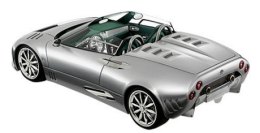 The prototype of C8 was first
unveiled to the public in 2000. However, the car was mostly unfinished
and it took the following years to refine. Spyker did produce a handful
of cars for its European customers, but series production was not
started until late 2005, when it found Karmann to produce the
aluminum chassis and body. At the same time, it obtained EPA approval
for importing to the USA. The prototype of C8 was first
unveiled to the public in 2000. However, the car was mostly unfinished
and it took the following years to refine. Spyker did produce a handful
of cars for its European customers, but series production was not
started until late 2005, when it found Karmann to produce the
aluminum chassis and body. At the same time, it obtained EPA approval
for importing to the USA.
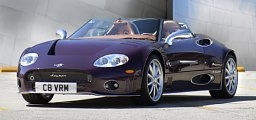 The
C8
is a mid-engined sports car employing aluminum spaceframe chassis and
body panels. As it was designed to be a spyder from the outset, chassis
stiffness has little difference with or without roof. High rigidity and
a pair of very strong (and thick) A-pillars means the car does not need
a windscreen header rail. This is the most special feature of the car.
Another specialty is the "butterfly" doors which swing upward and
outward around a single hinge to open, and it is electrically operated
! Thanks to the lightweight construction and an
all-alloy V8 engine, the C8 weighs only 1250 kilograms. The
C8
is a mid-engined sports car employing aluminum spaceframe chassis and
body panels. As it was designed to be a spyder from the outset, chassis
stiffness has little difference with or without roof. High rigidity and
a pair of very strong (and thick) A-pillars means the car does not need
a windscreen header rail. This is the most special feature of the car.
Another specialty is the "butterfly" doors which swing upward and
outward around a single hinge to open, and it is electrically operated
! Thanks to the lightweight construction and an
all-alloy V8 engine, the C8 weighs only 1250 kilograms.
Power
comes from an Audi
4.2-liter 40-valve V8. It is derived from the older non-FSI unit but
tuned up to 400 horsepower at 6800 rpm. Maybe one day it could switch
to the R8's 420hp FSI dry-sump unit. Transmission is a 6-speed manual
supplied by Getrag. Unlike Ferrari and Lamborghini, Spyker could not
afford to develop its own semi-automatic transmission. Power is sent to
the 265/30ZR19 rear tires. Like race cars, the C8 rides on long-arm
double-wishbone suspensions with inboard springs and dampers operated
by pushrods. Also like race cars, its steering and brakes are
unassisted. To save weight, to save development time or to save money,
nobody knows.
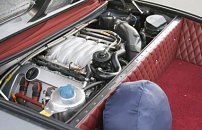 On the road, the Spyker
delivers a mixed impression. The engine noise is very, very loud, but
performance level does not live up to your expectation for a 400
horsepower and 1250 kilograms mid-engined machine. R&T found it
took 4.4 and 10.3 seconds to accelerate from 0-60 and 0-100 mph
respectively, which is about the same as a Porsche 911 Carrera S with
355 horsepower and 1420 kilograms kerb weight. Maybe Spyker has its own
methods for measuring power and weight. What hurts is, the C8 is priced
at £190,000 in UK or US$270,000 in USA, 3 times the price of the
911. In fact, the car is more expensive than the significantly faster
Ferrari F430 (£130,000), 599GTB (£170,000), Lamborghini
Gallardo (£120,000) and equals Lamborghini Murcielago LP640. On the road, the Spyker
delivers a mixed impression. The engine noise is very, very loud, but
performance level does not live up to your expectation for a 400
horsepower and 1250 kilograms mid-engined machine. R&T found it
took 4.4 and 10.3 seconds to accelerate from 0-60 and 0-100 mph
respectively, which is about the same as a Porsche 911 Carrera S with
355 horsepower and 1420 kilograms kerb weight. Maybe Spyker has its own
methods for measuring power and weight. What hurts is, the C8 is priced
at £190,000 in UK or US$270,000 in USA, 3 times the price of the
911. In fact, the car is more expensive than the significantly faster
Ferrari F430 (£130,000), 599GTB (£170,000), Lamborghini
Gallardo (£120,000) and equals Lamborghini Murcielago LP640.
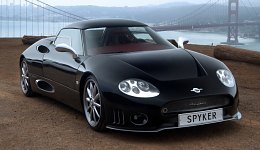 The
Spyker does handle very well. It balances well and corners rock-steady,
thanks to a stiff structure and even stiffer suspensions setting. In
this car, ride comfort is virtually non-existent except on the
smoothest highway, so any one driving it on B-roads should be prepared
to have his eyeballs rock off. The suspensions fail to dampen bumps to
the extent that handling could become very nervous. As expected, the
unassisted steering is heavy, but it is undoubtedly feelsome and
accurate. In contrast, the unservoed brake pedal brings no benefits
except an intensive training to your leg muscles, albeit a painful
training. The clutch is also very heavy. However, the most absurd is
probably the hand-brake, as it is inaccessible by the driver once he
has tightened the 4-point racing harness. The only way to actuate the
hand-brake is to ask your passenger for help. The
Spyker does handle very well. It balances well and corners rock-steady,
thanks to a stiff structure and even stiffer suspensions setting. In
this car, ride comfort is virtually non-existent except on the
smoothest highway, so any one driving it on B-roads should be prepared
to have his eyeballs rock off. The suspensions fail to dampen bumps to
the extent that handling could become very nervous. As expected, the
unassisted steering is heavy, but it is undoubtedly feelsome and
accurate. In contrast, the unservoed brake pedal brings no benefits
except an intensive training to your leg muscles, albeit a painful
training. The clutch is also very heavy. However, the most absurd is
probably the hand-brake, as it is inaccessible by the driver once he
has tightened the 4-point racing harness. The only way to actuate the
hand-brake is to ask your passenger for help.
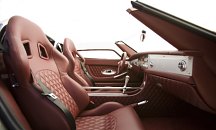 The handling character is
old-fashion for its instantaneous response and honesty. There are pros
and cons - on the up side, its steering tendency is as neutral as a
race car. You can apply throttle and steering to induce oversteer in
corners easily. On the down side, if you abuse it, the tail-happy
machine will go wide and spin off the track, very old-fashion indeed.
The Spyker does not have any electronic safety nets like ESP, traction
control or active differential, so you can only rely on your driving
skill to keep you save on track. Should you really crash, there are no
airbags to save you. In this way, the Spyker is very much like a TVR,
albeit a TVR at four times the price. The handling character is
old-fashion for its instantaneous response and honesty. There are pros
and cons - on the up side, its steering tendency is as neutral as a
race car. You can apply throttle and steering to induce oversteer in
corners easily. On the down side, if you abuse it, the tail-happy
machine will go wide and spin off the track, very old-fashion indeed.
The Spyker does not have any electronic safety nets like ESP, traction
control or active differential, so you can only rely on your driving
skill to keep you save on track. Should you really crash, there are no
airbags to save you. In this way, the Spyker is very much like a TVR,
albeit a TVR at four times the price.
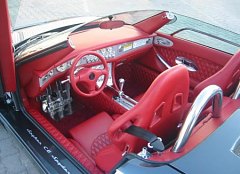 So, why are there some people
willing to pay so much money for a TVR alike ? you may get the answer
from the cockpit. With plenty of bespoke gauges, mechanical toggle
switches, milled aluminum dashboard, quilted Connolly leather trim, a
beautifully exposed aluminum gearshift linkage and an aluminum-spoke
steering wheel mirroring a propeller of pre-war aircrafts, the Spyker
brings back the memory of the most luxurious cars in the 1920s and 30s.
There is hardly any trace of plastics in this cabin. Everything is
finished in classical style with the best materials and craftsmanship,
not even Italian or British exotics can compare with. Well, with the
exception of Pagani perhaps. It is this exclusivity that brings dosens
of customers annually to Spyker. So, why are there some people
willing to pay so much money for a TVR alike ? you may get the answer
from the cockpit. With plenty of bespoke gauges, mechanical toggle
switches, milled aluminum dashboard, quilted Connolly leather trim, a
beautifully exposed aluminum gearshift linkage and an aluminum-spoke
steering wheel mirroring a propeller of pre-war aircrafts, the Spyker
brings back the memory of the most luxurious cars in the 1920s and 30s.
There is hardly any trace of plastics in this cabin. Everything is
finished in classical style with the best materials and craftsmanship,
not even Italian or British exotics can compare with. Well, with the
exception of Pagani perhaps. It is this exclusivity that brings dosens
of customers annually to Spyker.
If you want to demonstrate your taste and wealth, the Spyker will be a
fine purchase. However, if you want to enjoy performance and the thrill
of
driving like most people do, then you will find plenty of superior
choices from Ferrari, Porsche and Lamborghini. Compare with those
established marques, the Spyker has too many
flaws and its talent is too limited. |
| The
above report was last updated on 11 Mar
2007. All Rights Reserved. |
C12 LaTurbie (prototype)
|
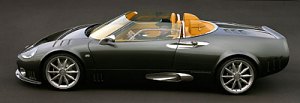 Spyker
unveiled C12 LaTurbie in the 2005 Geneva motor show as a bigger brother
of C8. As indicated by its name, it employs a more powerful 12-cylinder
engine, this time the 6.0-liter W12 engine that powered the top Audi
A8. Spyker tuned the engine from the stock 450 horsepower to 500
horsepower, accompany with a boost in maximum torque from 428 lbft to
442 lbft. Performance is claimed to be 196 mph and 0-60 mph in 3.8
seconds. That should place it near the league of Lamborghini Murcielago
and Ferrari 599 GTB. Spyker
unveiled C12 LaTurbie in the 2005 Geneva motor show as a bigger brother
of C8. As indicated by its name, it employs a more powerful 12-cylinder
engine, this time the 6.0-liter W12 engine that powered the top Audi
A8. Spyker tuned the engine from the stock 450 horsepower to 500
horsepower, accompany with a boost in maximum torque from 428 lbft to
442 lbft. Performance is claimed to be 196 mph and 0-60 mph in 3.8
seconds. That should place it near the league of Lamborghini Murcielago
and Ferrari 599 GTB.
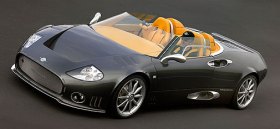 Unfortunately, no one could
verify these claims. Until now, no automotive journalists have ever
driven the car. Is it still under development ? no one knows. One thing
is for sure - since the introduction of the D12 SSUV, Spyker has
shifted its focus from the C12. We can understand why. The C12 has to
fight an uphill battle against Ferrari, Lamborghini, Mercedes-McLaren,
Pagani, Koenigsegg etc. while the 4-seat super offroader has virtually
no competitors in the market, so the latter should be the future of
Spyker. Unfortunately, no one could
verify these claims. Until now, no automotive journalists have ever
driven the car. Is it still under development ? no one knows. One thing
is for sure - since the introduction of the D12 SSUV, Spyker has
shifted its focus from the C12. We can understand why. The C12 has to
fight an uphill battle against Ferrari, Lamborghini, Mercedes-McLaren,
Pagani, Koenigsegg etc. while the 4-seat super offroader has virtually
no competitors in the market, so the latter should be the future of
Spyker.
Despite
of occupying a higher category, the C12 is derived from C8. The
aluminum space frame chassis is stretched by 65mm in wheelbase to
improve stability rather than to accommodate the engine, because the
ultra-compact W12 is even shorter than the V8. The body is widened
considerably, as are the front and rear overhangs. However, the
suspensions, transmission, exterior design and the impeccably built
cabin are mostly carried over from the C8, so we expect it to succeed
the strengths and flaws of its brother.
In late 2007, Spyker revealed that the development of C12 and its
Zagato-bodied version had been cancelled (due to its poor financial
condition, you know). Now its energy will be concentrated back on the
V8 model and offroader.
|
| The
above report was written on 11 Mar
2007 and last updated on 13 Aug 2009. All
Rights Reserved. |
|
|